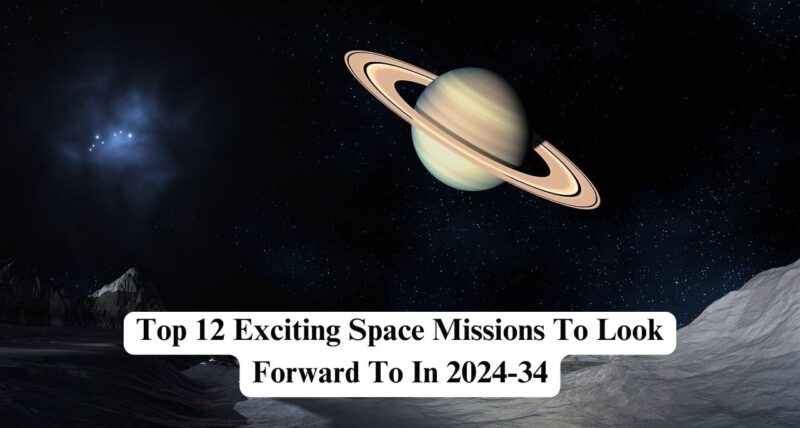From NASA launching JWST (James Webb Space Telescope) to India’s success in reaching the Moon’s southern part, 2023 was all exclusive and extraordinary. Our journey in space discovery has progressed tremendously. But there is always a scope for more, trying to discover the vast vacuum that lies outside the Earth’s premises. Here is a list of 12 upcoming space missions to look forward to in the decade 2024-34.
Europa Clipper

Our first on the list of upcoming space missions is NASA’s Europa Clipper mission. It is scheduled to launch in October 2024. To better explore Jupiter’s moon Europa, which has a salty ocean larger than that of Earth. The mission will investigate Jupiter’s moon Europa. It will conduct almost 50 flybys to examine its icy crust, surface geology, and subterranean ocean.
Artemis II Launch
NASA plans to fly four humans around the moon and back over ten days on its mission, Artemis 2. The project is named after the Greek mythological twin sister of Apollo. It is planned to launch in November 2024.
Starliner
NASA has awarded Boeing around $5 billion over the last ten years to construct this spacecraft. The spaceship is finally scheduled to start delivering crews to the International Space Station in April, following several delays. As early as 2025, if everything goes according to plan, Boeing might start regularly transporting NASA personnel to and from the ISS.
New Glenn
One of our most eagerly awaited space missions of 2023 was the heavy-lift reusable rocket, New Glenn. Blue Origin, the aerospace company owned by Jeff Bezos, has been constructing since 2012. However, that launch did not occur and is postponed to late 2024. The rocket’s goal is to lift off and begin a new science mission by NASA called EscaPADE, which will investigate the magnetosphere of Mars.
Ariane 6
The European Space Agency (ESA) has used Arianespace’s Ariane 5 rocket (heavy-lift) as its main launch vehicle since 1996 until it was retired in 2023. The company is anticipated to launch the rocket’s replacement for the first time in 2024 (mid). The 207-foot-tall rocket will be the largest to launch from Europe when that occurs.
Martian Moons eXploration
Among the upcoming space missions is the Martian Moons eXploration (MMX). The spacecraft will circle Mars while gathering data and carrying out scientific investigations. It will study the Martian moons. It also aims to find out whether they were formed after a collision or captured by asteroids. The current launch schedule is 2026!
VIPER Moon Mission

In late 2024, NASA intends to deploy VIPER, a robot the size of a golf cart, to investigate the Moon’s south pole. The mission was delayed to complete testing of Astrobotic’s lander technology. The aim is to locate volatiles, or substances like water and carbon dioxide, that evaporate readily at lunar temperatures. The robot will traverse frigid, dark places and lunar daylight using heat pipes, radiators, and batteries. November 2024 is when the launch has been planned to occur.
Parker Solar Probe
Launched in 2021, it became the first spacecraft to enter the solar atmosphere. By December 2024, it is expected to have made all 24 orbits around the sun, traveling as close to the surface as 3.9 million miles. To enable more accurate measurements and forecasts of solar wind and its effects on life on Earth, the mission seeks to deliver new knowledge about the Sun. The probe is built to withstand the intense 1,377°C heat from the star. Hence, it will aid in our understanding of solar wind and the sun’s higher-temperature corona.
Starship
The most notable space stories of 2023 were the first and second test flights of SpaceX’s Starship rocket. Both of which ended in explosions, even if the second mission did make it to space. SpaceX plans to launch many Starships in 2024. Hence, there’s a considerable probability that one of the enormous rockets will successfully finish a mission. This will be an important step towards returning people to the moon using rockets and eventually landing boots on Mars.
ESA’s Hera Mission

The goal of ESA’s Hera mission is to revisit the Didymos-Dimorphos asteroid system, which was last visited by NASA’s DART mission in 2022. The mission will investigate the effects of the DART impact, which altered the asteroid’s trajectory. It may help reroute potentially dangerous objects that were headed toward Earth. Hera will take off in October 2024 and return in late 2026 to investigate the physical characteristics of the asteroids.
Breakthrough Starshot
In fewer than 20 years, a spacecraft named StarChips, led by scientists Stephen Hawking and Mark Zuckerberg, is scheduled to be sent to Alpha Centauri, our neighboring star system. The mission, which made its public debut in 2016, uses lasers on Earth to travel 15-20% at the speed of light. The mission will fly over the distant planet Proxima Centauri B in the habitable zone of the star system to test the feasibility of superfast spaceflight.
Laser Interferometer Space Antenna
To detect faint gravity waves smaller than 20 picometers over a million kilometers, the LISA mission will deploy three satellites separated 2.5 million kilometers apart. This will make it possible to research black hole properties and locations as well as Einstein’s ideas.
The goal of exploring space has long been a dream of humanity, and years ago it was realized. These upcoming space missions will further demonstrate the potential of humanity and advance our understanding of the cosmos significantly.



